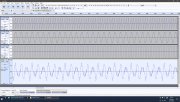Always amazed me too Lee as well that a driver could do all that simultaneously. The ear part, nah, our best engineer on that one so I never wondered there. But the little cone doing all those frequencies and responses so accurately, made out of paper, all at the same time is a tough one it would seem. That Celestion scan showing what parts move in relation to the input would be interesting thing to see, might help wrap our minds around it better. The voice coil must do all within the required freq range, for sure, the cone, might see some differences in relation to distance from the VC, esp on the bigger cones.
And dual voice coils in same driver, one responsible for different frequencies than the other, more wizardry. Joe's explanation was like the sex explanation to a young child,, missing some important details I think! Maybe he is protecting our fragile minds.......


